Misalignment Fault Diagnosis for Wind Turbines Based on Information Fusion
Abstract
:1. Introduction
- Data level fusion. The direct fusion of signals collected by the same type of sensors retains the most information among the three levels.
- Feature level fusion. In this process, the signals from multiple sensors need to be preprocessed. Features are extracted to form the fusion vector and its attributes are used to judge the state of targets to be diagnosed.
- Decision level fusion. After initial state judgment of the target to be diagnosed, the final state is obtained based on the fusion of some decision rules. Decision level fusion is the highest among the three levels. Its real-time performance and fault tolerance are very good, but the information loss is very large, so more complex algorithms are needed.
2. Theoretical Background
2.1. D–S Evidence Theory
- Frame of discernment:
- Basic probability assignment (BPA) function:
- Belief function:
- Plausibility function:
- Dempster’s rule of combination:
- Decision rules:
2.2. Posterior Probability Least Squares Support Vector Machine
2.3. The Improved Artificial Bee Colony
3. Specific Steps for Misalignment Diagnosis
4. The Simulation Case Studies of Misalignment Fault Diagnosis
4.1. Data Processing
4.2. The Fault Diagnosis Results
5. Experimental Verification of Platform
6. Conclusions
Author Contributions
Funding
Conflicts of Interest
References
- Junior, P.R.; Fischetti, E.; Araújo, V.G.; Peruchi, R.S.; Aquila, G.; Rocha, L.C.S.; Lacerda, L.S. Wind power economic feasibility under uncertainty and the application of ANN in sensitivity analysis. Energies 2019, 12, 2281. [Google Scholar] [CrossRef] [Green Version]
- Liu, Z.; Zhang, L.; Carrasco, J. Vibration analysis for large-scale wind turbine blade bearing fault detection with an empirical wavelet thresholding method. Renew. Energy 2020, 146, 99–110. [Google Scholar] [CrossRef]
- Hu, A.; Yan, X.; Xiang, L. A new wind turbine fault diagnosis method based on ensemble intrinsic time-scale decomposition and WPT-fractal dimension. Renew. Energy 2015, 83, 767–778. [Google Scholar] [CrossRef]
- Zheng, H. Case analysis of wind turbine vibration monitoring. Wind Energy 2014, 2017, 88–92. (In Chinese) [Google Scholar] [CrossRef]
- Liao, M.; Liang, Y.; Wang, S.; Wang, Y. Analysis of misalignment of wind turbines. Mech. Sci. Technol. Aerosp. Eng. 2011, 2011, 173–180, (In Chinese with English abstract). [Google Scholar] [CrossRef]
- Liu, Z.; Zhang, L. A review of failure modes, condition monitoring and fault diagnosis methods for large-scale wind turbine bearings. Measurement 2020, 149, 107002. [Google Scholar] [CrossRef]
- Simani, S.; Fantuzzi, C. Dynamic system identification and model-based fault diagnosis of an industrial gas turbine prototype. Mechatronics 2006, 16, 341–363. [Google Scholar] [CrossRef]
- Tang, H.; Lam, K.-M.; Shum, K.-M.; Li, Y. Wake effect of a horizontal axis wind turbine on the performance of a downstream turbine. Energies 2019, 12, 2395. [Google Scholar] [CrossRef] [Green Version]
- Zhao, Q.; Han, T.; Jiang, D.; Yin, K. Application of variational mode decomposition to feature isolation and diagnosis in a wind turbine. J. Vib. Eng. Technol. 2019, 7, 639–646. [Google Scholar] [CrossRef]
- Abdalla, G.M.; Tian, X.; Zhen, D.; Gu, F.; Ball, A.; Chen, Z. Misalignment diagnosis of a planetary gearbox based on vibration analysis. In Proceedings of the 21st International Congress on Sound and Vibration, Beijing, China, 13–17 July 2014; Volume 4, pp. 2775–2783. Available online: https://www.researchgate.net/publication/286770020 (accessed on 20 January 2021).
- Huang, Q.; Jiang, D.X.; Hong, L.Y. Application of Hilbert-Huang transform method on fault diagnosis for wind turbine rotor. Key Eng. Mater. 2009, 413, 159–166. [Google Scholar] [CrossRef]
- An, M.-S.; Kang, D.-S. Application of modified empirical mode decomposition method to fault diagnosis of offshore wind turbines. Int. J. Multimed. Ubiquitous Eng. 2016, 11, 67–80. [Google Scholar] [CrossRef]
- Villa, L.F.; Reñones, A.; Perán, J.R.; De Miguel, L.J. Statistical fault diagnosis based on vibration analysis for gear test-bench under non-stationary conditions of speed and load. Mech. Syst. Signal Process. 2012, 29, 436–446. [Google Scholar] [CrossRef]
- He, G.; Ding, K.; Li, L.; Deng, R. Vibration test and analysis of transmission chain of wind turbine based on double-elastic support. J. South China Univ. Technol. (Nat. Sci. Ed.) 2014, 2014, 90–97, (In Chinese with English abstract). [Google Scholar] [CrossRef]
- Bossé, E.; Rogova, G.L. Information Quality in Information Fusion and Decision Making; Information Fusion and Data Science; Springer: Berlin/Heidelberg, Germany, 2019; pp. 1–49. [Google Scholar]
- Mönks, U. Information Fusion under Consideration of Conflicting Input Signals; Technologien für die intelligente Automation; Springer: Berlin/Heidelberg, Germany, 2017; pp. 11–35. [Google Scholar]
- Wald, L. Some terms of reference in data fusion. IEEE Trans. Geosci. Remote Sens. 1999, 37, 1190–1193. [Google Scholar] [CrossRef] [Green Version]
- Zeng, Q.; Liu, X. Research on Bayesian classification algorithm. Biotechnol. World 2015, 35, 253–255. (In Chinese) [Google Scholar]
- Dubois, D.; Liu, W.; Ma, J.; Prade, H. The basic principles of uncertain information fusion. An organised review of merging rules in different representation frameworks. Inf. Fusion 2016, 32, 12–39. [Google Scholar] [CrossRef]
- Yao, P. Research on Fuzzy Multiple Attribute Decision Making Method for Process Industry Fault Diagnosis; Qilu University of Technology: Jinan, China, 2019; (In Chinese with English abstract). [Google Scholar]
- Li, W.-W.; Wu, C. A multicriteria interval-valued intuitionistic fuzzy set topsis decision-making approach based on the improved score function. J. Intell. Syst. 2016, 25, 239–250. [Google Scholar] [CrossRef]
- Su, C.-H.; Chen, T.-L.; Cheng, C.-H.; Chen, Y.-C. Forecasting the stock market with linguistic rules generated from the minimize entropy principle and the cumulative probability distribution approaches. Entropy 2010, 12, 2397–2417. [Google Scholar] [CrossRef]
- Wang, M.; Zhang, Z.; Pei, P. Application of information fusion technology in fault diagnosis of large generators. Comput. Simul. 2012, 29, 349–352, (In Chinese with English abstract). [Google Scholar] [CrossRef]
- Li, Y.; Xu, Y.; Chen, G.; Miao, R.; Yu, J. Improvement and application of D-S evidence theory in multi-sensor fault diagnosis. J. Southeast Univ. (Nat. Sci. Ed.) 2011, 41, 102–106, (In Chinese with English abstract). [Google Scholar] [CrossRef]
- Jiang, W.; Wu, S. Multi-data fusion fault diagnosis method based on SVM and evidence theory. Chin. J. Sci. Instrum. 2010, 31, 1738–1743, (In Chinese with English abstract). [Google Scholar] [CrossRef]
- Hu, J.; Yu, Z.; Zhai, X.; Peng, J.; Ren, L. Research on fault diagnosis and fusion diagnosis of aero-engine rotor based on improved D-S evidence theory. Acta Aeronaut. Astronaut. Sin. 2014, 35, 436–443, (In Chinese with English abstract). [Google Scholar]
- Tian, Y.; Liu, S.; Jing, Y.; Yang, Y. Fault prediction of wind turbines based on D-S evidence fusion. Comput. Mod. 2017, 2017, 57–61, (In Chinese with English abstract). [Google Scholar] [CrossRef]
- Kang, J.; Gu, Y.; Li, Y. Multi-sensor information fusion algorithm based on DS evidence theory. J. Chin. Inert. Technol. 2012, 20, 670–673, (In Chinese with English abstract). [Google Scholar] [CrossRef]
- Zhou, H.; Li, S. The combination of support vector machine and evidence theory in information fusion. J. Transduct. Technol. 2008, 21, 1566–1570, (In Chinese with English abstract). [Google Scholar] [CrossRef]
- Boudraa, A.O.; Bentabet, L.; Salzenstein, F.; Guillon, L. Dempster-Shafer’s basic probability assignment based on fuzzy membership functions. ELCVIA 2004, 4, 1–10. Available online: https://www.researchgate.net/publication/39087167 (accessed on 20 February 2021). [CrossRef]
- Haenni, R. Shedding new light on Zadeh’s criticism of Dempster’s rule of combination. In Proceedings of the 2005 7th International Conference on Information Fusion, Philadelphia, PA, USA, 25–28 July 2005; Volume 2, p. 33. [Google Scholar]
- Li, W.; Guo, K. Combination rules of D-S evidence theory and conflict problem. Syst. Eng. Theory Pract. 2010, 30, 1422–1432, (In Chinese with English abstract). [Google Scholar]
- Zhang, X.; Xiao, X.; Xu, G. Weighted posterior probability output for support vector machines. J. Tsinghua Univ. (Sci. Tech.) 2007, 47, 1689–1691, (In Chinese with English abstract). [Google Scholar] [CrossRef]
- Wang, J.P.; De Lin, S.; Bao, Z.F. Neural network and D-S evidence theory based condition monitoring and fault diagnosis of drilling. Appl. Mech. Mater. 2012, 249, 481–486. [Google Scholar] [CrossRef]
- Lin, H.-T.; Lin, C.-J.; Weng, R.C. A note on Platt’s probabilistic outputs for support vector machines. Mach. Learn. 2007, 68, 267–276. [Google Scholar] [CrossRef] [Green Version]
- Zhao, F. Detection method of LSSVM network intrusion based on hybrid kernel function. Mod. Electron. Technol. 2015, 38, 97–99, (In Chinese with English abstract). [Google Scholar]
- Yuan, X.; Wang, P.; Yuan, Y.; Huang, Y.; Zhang, X. A new quantum inspired chaotic artificial bee colony algorithm for optimal power flow problem. Energy Convers. Manag. 2015, 100, 1–9. [Google Scholar] [CrossRef]
- Yi, Y.; He, R. A novel artificial bee colony algorithm. In Proceedings of the 2014 Sixth International Conference on Intelligent Human-Machine Systems and Cybernetics, Hangzhou, China, 26–27 August 2014; pp. 271–274. [Google Scholar]
- Chen, W.; Xiao, Y. An improved ABC algorithm and its application in bearing fault diagnosis with EEMD. Algorithms 2019, 12, 72. [Google Scholar] [CrossRef] [Green Version]
- Xiao, Y.; Kang, N.; Hong, Y.; Zhang, G. Misalignment fault diagnosis of DFWT based on IEMD energy entropy and PSO-SVM. Entropy 2017, 19, 6. [Google Scholar] [CrossRef]
- Xiao, Y.; Hong, Y.; Chen, X.; Chen, W. The application of dual-tree complex wavelet transform (DTCWT) energy entropy in misalignment fault diagnosis of doubly-fed wind turbine (DFWT). Entropy 2017, 19, 587. [Google Scholar] [CrossRef] [Green Version]
- Zhang, G. Thermal Characteristics Analysis of High Speed Transmission System of Wind Turbines. Master’s Thesis, Beijing Jiaotong University, Beijing, China, 2017. (In Chinese with English abstract). [Google Scholar]
- Xiao, Y.; Wang, Y.; Ding, Z. The Application of heterogeneous information fusion in misalignment fault diagnosis of wind turbines. Energies 2018, 11, 1655. [Google Scholar] [CrossRef] [Green Version]
- Shao, R.; Hu, W.; Wang, Y.; Qi, X. The fault feature extraction and classification of gear using principal component analysis and kernel principal component analysis based on the wavelet packet transform. Measurement 2014, 54, 118–132. [Google Scholar] [CrossRef]
- Zhang, Y.; Li, Y. Fisher information metric based on stochastic neighbor embedding. J. Beijing Univ. Technol. 2016, 42, 863–869, (In Chinese with English abstract). [Google Scholar]

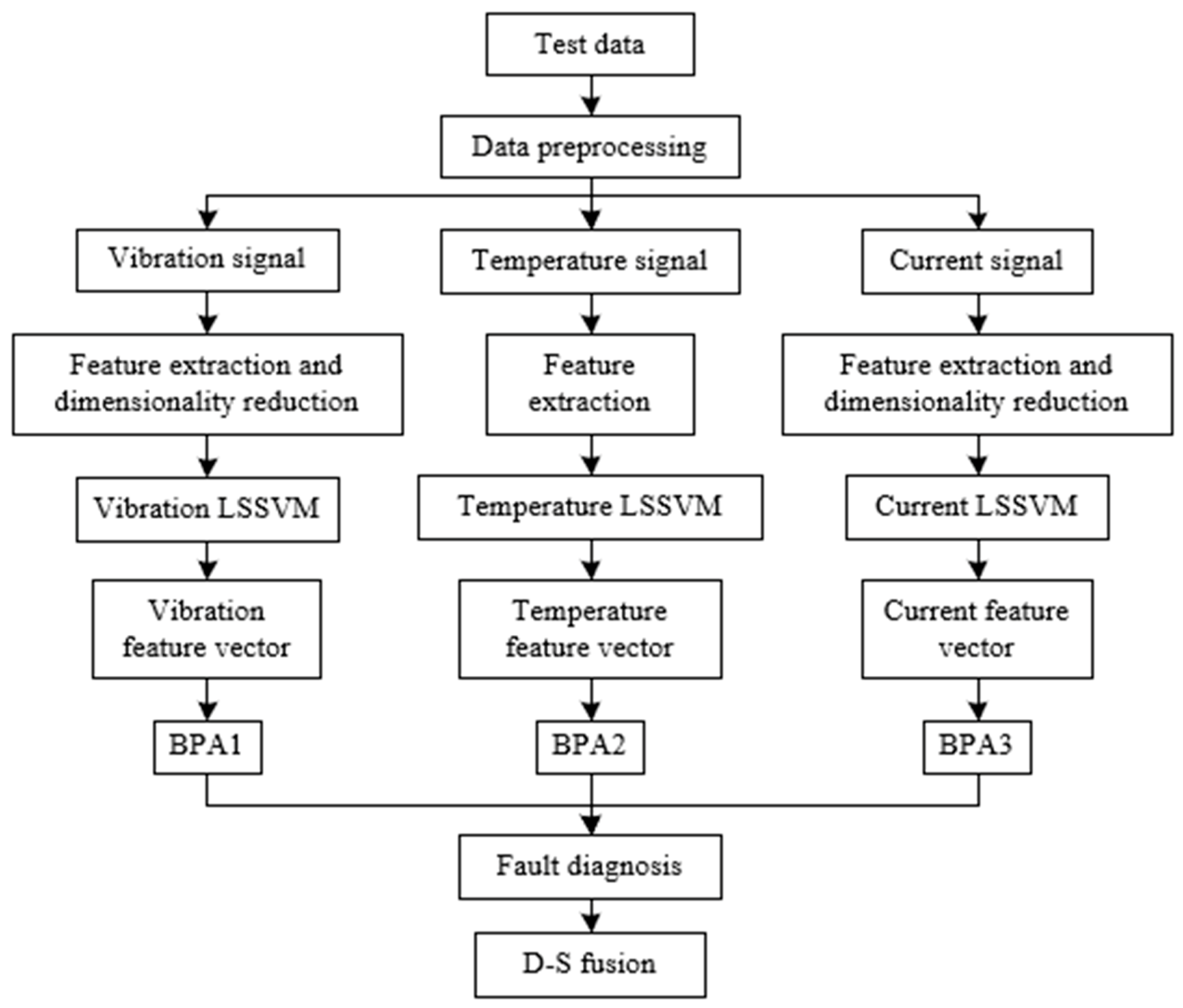
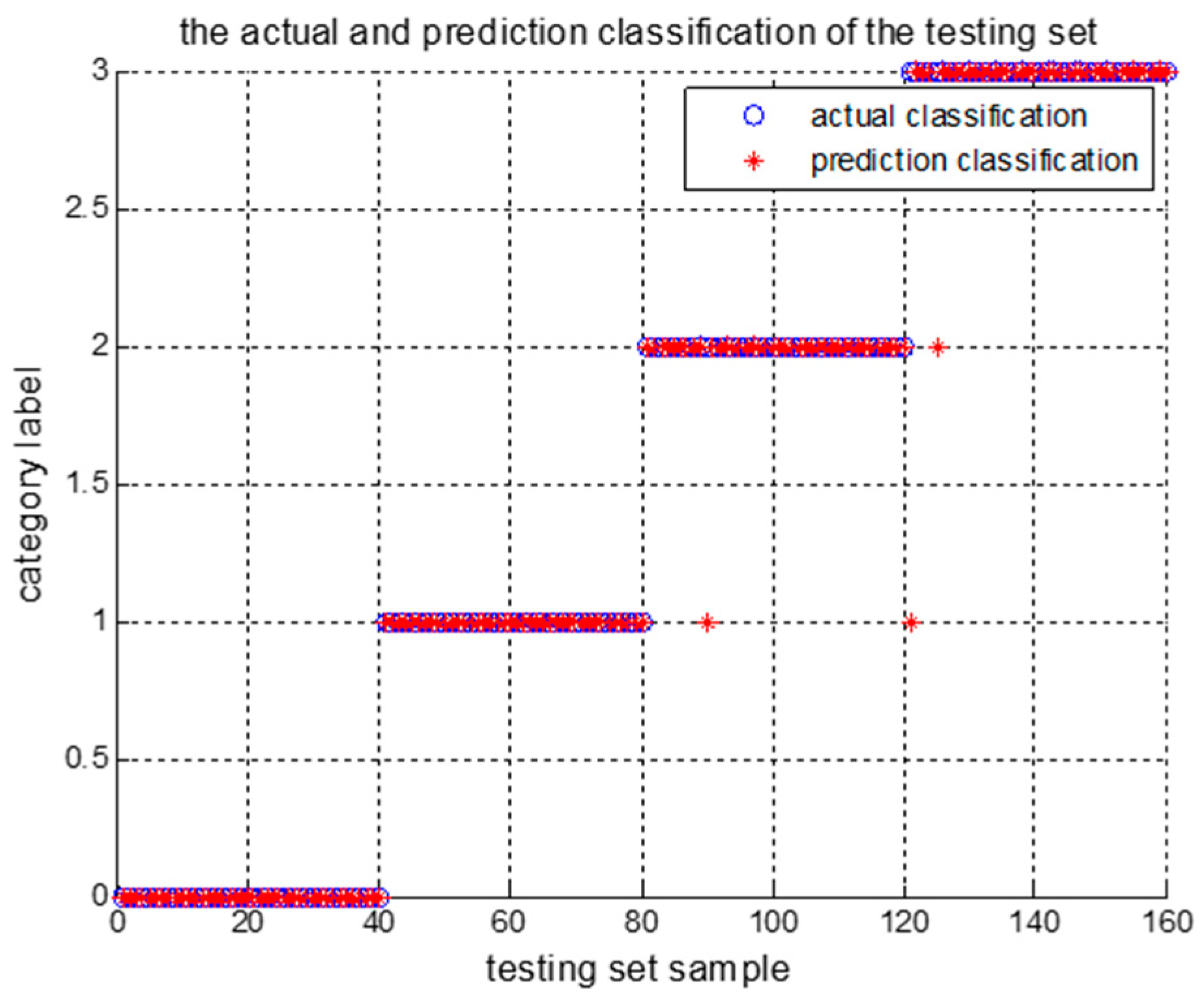
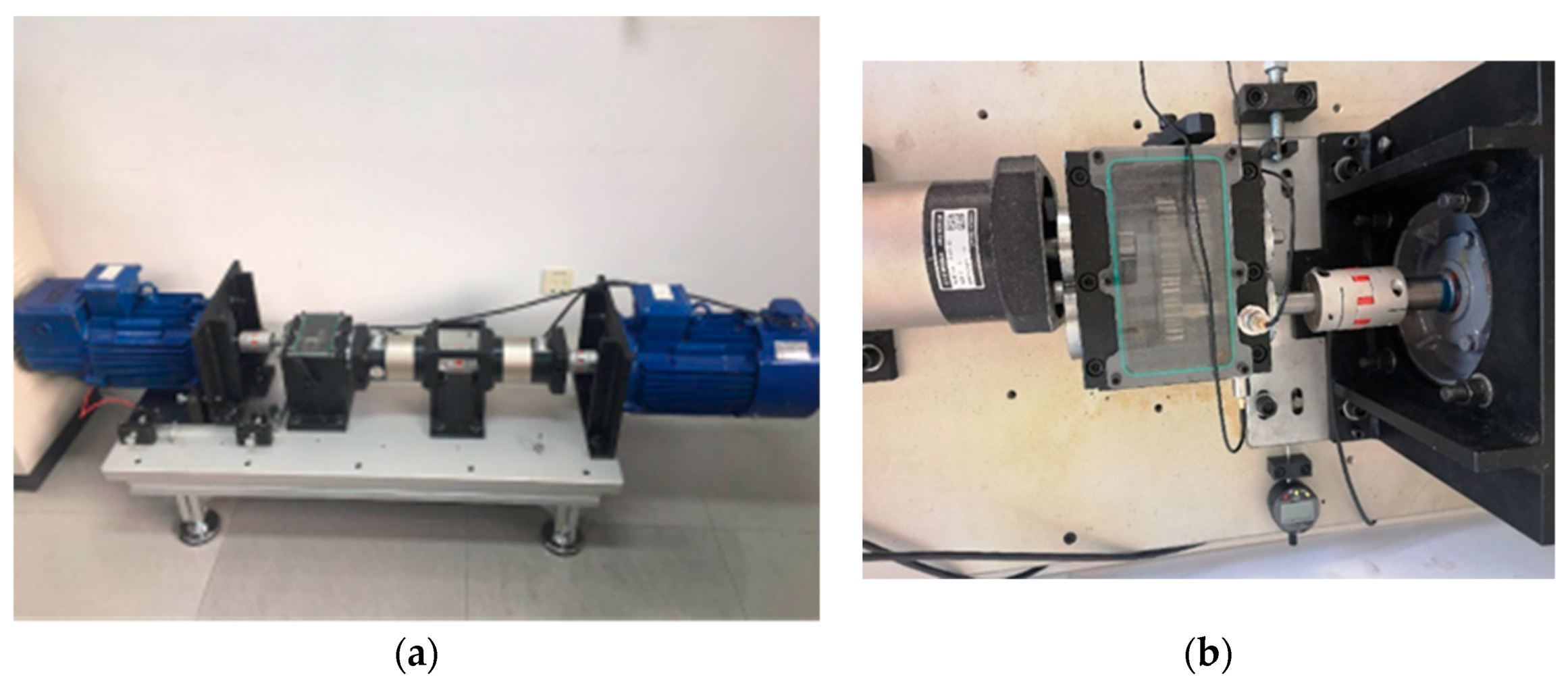
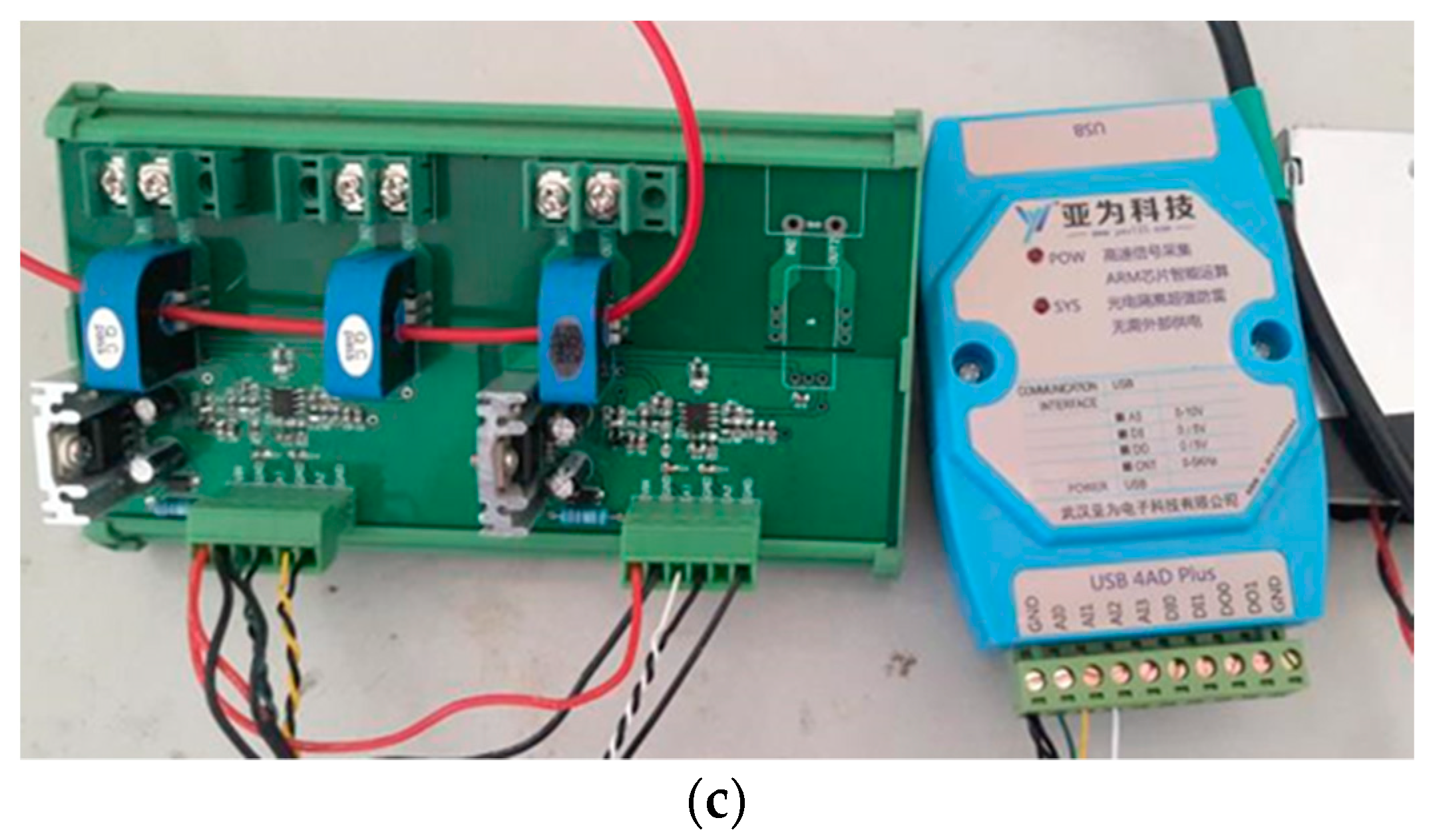
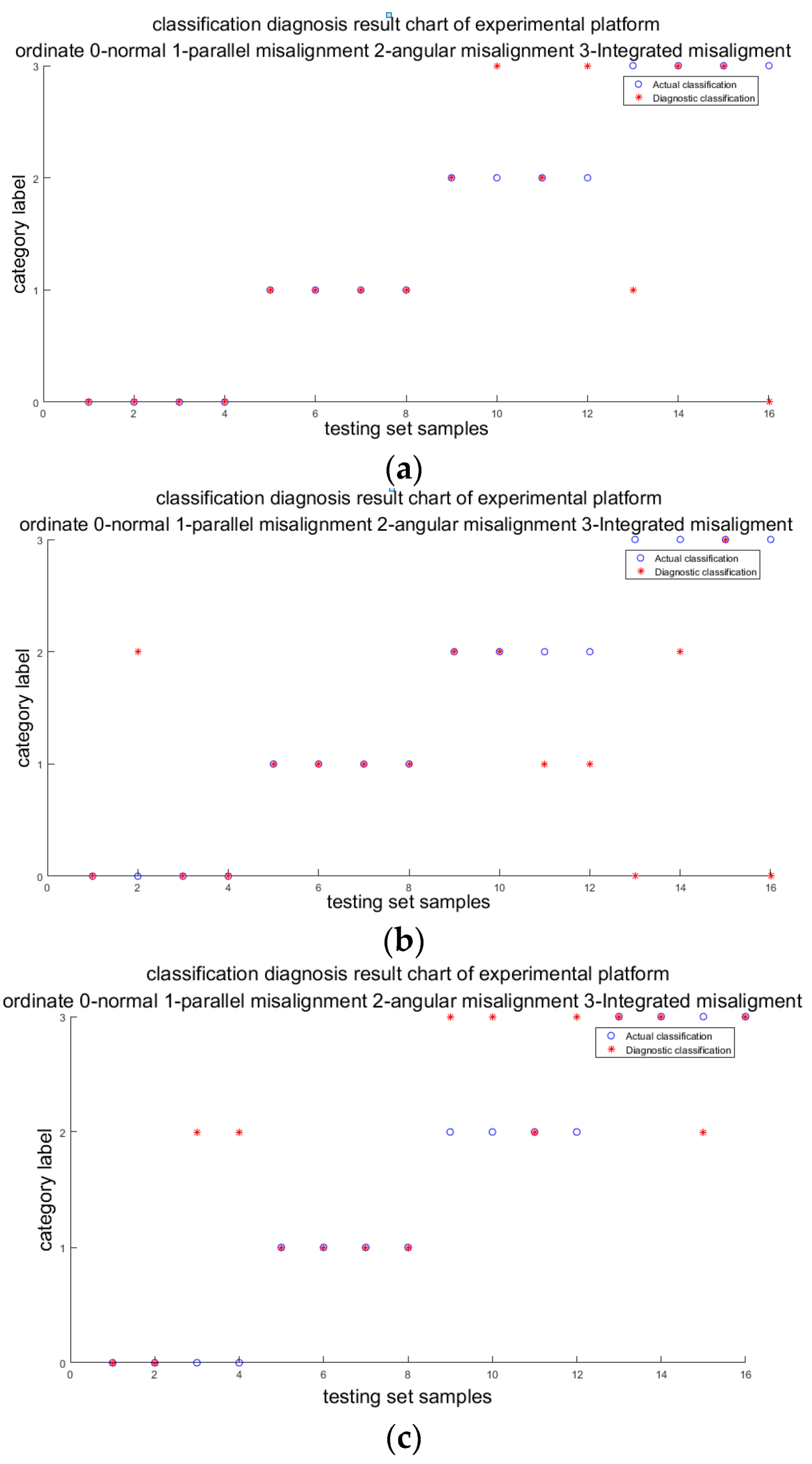
| Approach | Advantages | Disadvantages |
|---|---|---|
| Bayes’ theorem | Takes probability as the input data, has sufficient theoretical knowledge | Difficult to define prior probability function, lacks the ability to allocate the total uncertainty |
| D–S evidence theory | The premise is easier to meet, no need to know prior probability | Cannot solve the serious conflict or complete conflict of evidences |
| Fuzzy set theory | Based on local theory of classification, has strong adaptive ability | Determines the uncertainty according to the subjective judgement |
| Rough set theory | Deals with redundant information and inconsistent information effectively | Discretization of symptom attributes is needed |
| Feature Library | Feature | Index |
|---|---|---|
| Mixed-domain feature library | Time domain | Root mean square, square root amplitude, variance, standard deviation, kurtosis, waveform index, peak index, pulse index, margin index, kurtosis index |
| Frequency domain | Center of gravity frequency, mean square frequency, frequency variance | |
| Time–frequency domain | The first eight energy entropy of the IMF (intrinsic mode function) component of IEMD decomposition |
| Time Domain Index | Calculation Formula | |
|---|---|---|
| Dimensional indicators | Root mean square Square root amplitude Variance Standard deviation Kurtosis | |
| Dimensionless index | Waveform index Peak index Pulse index Margin index Kurtosis index | |
| Frequency Domain Index | Calculation Formula |
|---|---|
| Center of gravity frequency Mean square frequency Root mean square frequency Frequency variance |
| Feature Library | Feature | Index |
|---|---|---|
| Mixed-domain feature library | Time domain | Root mean square, square root amplitude, variance, standard deviation, kurtosis, waveform index, peak index, pulse index, margin index, kurtosis index |
| Frequency domain | Center of gravity frequency, mean square frequency, root mean square frequency, frequency variance | |
| Time–frequency domain | Sample entropy 1–5, energy entropy H1, H2, H3, H4, H5, spectral kurtosis a1, a2, a3, a4, a5 |
| LSSVM | A | B | ||
|---|---|---|---|---|
| (normal, the rest) | 84.2784 | 31.1601 | −10.8211 | −4.2378 |
| (parallel misalignment, the rest) | 85.8947 | 30 | −7.4866 | −1.9740 |
| (angular misalignment, the rest) | 36.0326 | 39.9616 | −6.1128 | −1.5637 |
| (integrated misalignment, the rest) | 99.4093 | 96.6015 | −6.9786 | −2.4798 |
| Sample Number | Normal | Parallel Misalignment | Angular Misalignment | Integrated Misalignment |
|---|---|---|---|---|
| 5 | 0.8433 | 0.0314 | 0.0538 | 0.0715 |
| 44 | 0.0080 | 0.9246 | 0.0295 | 0.0379 |
| 82 | 0.0025 | 0.0070 | 0.8873 | 0.1032 |
| 130 | 0.0208 | 0.0147 | 0.0495 | 0.9150 |
| LSSVM | A | B | ||
|---|---|---|---|---|
| (normal, the rest) | 97.4952 | 89.7017 | −3.0178 | −0.4262 |
| (parallel misalignment, the rest) | 98.3829 | 30 | −2.8893 | 0.1963 |
| (angular misalignment, the rest) | 46.3907 | 88.9951 | −3.9974 | −0.3622 |
| (integrated misalignment, the rest) | 93.6931 | 96.3611 | −2.4749 | 0.3805 |
| Sample Number | Normal | Parallel Misalignment | Angular Misalignment | Integrated Misalignment |
|---|---|---|---|---|
| 5 | 0.7418 | 0.0387 | 0.0228 | 0.1967 |
| 44 | 0.1314 | 0.7670 | 0.0243 | 0.0773 |
| 82 | 0.3644 | 0.0357 | 0.5549 | 0.0450 |
| 130 | 0.4365 | 0.0394 | 0.0220 | 0.5021 |
| LSSVM | A | B | ||
|---|---|---|---|---|
| (normal, the rest) | 35.2345 | 53.0811 | −4.858 | −0.6011 |
| (parallel misalignment, the rest) | 87.5286 | 30 | −3.2022 | −0.1165 |
| (angular misalignment, the rest) | 100 | 30 | −3.2755 | −0.2514 |
| (integrated misalignment, the rest) | 77.1503 | 33.2639 | −3.2803 | −0.2146 |
| Sample Number | Normal | Parallel Misalignment | Angular Misalignment | Integrated Misalignment |
|---|---|---|---|---|
| 5 | 0.8635 | 0.0440 | 0.0468 | 0.0457 |
| 44 | 0.0164 | 0.6193 | 0.3159 | 0.0484 |
| 82 | 0.0170 | 0.1236 | 0.8093 | 0.0501 |
| 130 | 0.0127 | 0.1093 | 0.0521 | 0.8259 |
| BPA 1 | BPA 2 | BPA3 | D–S Evidence Fusion |
|---|---|---|---|
| [0.8433, 0.0314, 0.0538, 0.0715] | [0.7418, 0.0387, 0.0228, 0.1967] | [0.8635, 0.0440, 0.0468, 0.0457] | [0.9986, 0.0001, 0.0001, 0.0012] |
| [0.0080, 0.9246, 0.0295, 0.0379] | [0.1314, 0.7670, 0.0243, 0.0773] | [0.0164, 0.6193, 0.3159, 0.0484] | [0.0001, 0.9991, 0.0005, 0.0003] |
| [0.0025, 0.0070, 0.8873, 0.1032] | [0.3644, 0.0357, 0.5549, 0.0450] | [0.0170, 0.1236, 0.8093, 0.0501] | [0.0001, 0.0001, 0.9993, 0.0005] |
| [0.0208, 0.0147, 0.0495, 0.9150] | [0.4365, 0.0394, 0.0220, 0.5021] | [0.0127, 0.1093, 0.0521, 0.8259] | [0.0003, 0.0002, 0.0001, 0.9994] |
| D–S Evidence Fusion | Category | Is the Classification Correct? |
|---|---|---|
| [0.9986, 0.0001, 0.0001, 0.0012] | Normal | Yes |
| [0.0001, 0.9991, 0.0005, 0.0003] | Parallel misalignment | Yes |
| [0.0001, 0.0001, 0.9993, 0.0005] | Angular misalignment | Yes |
| [0.0003, 0.0002, 0.0001, 0.9994] | Integrated misalignment | Yes |
| Signal Selection | Training Set Classification Accuracy | Testing Set Classification Accuracy | False Alarm Rate |
|---|---|---|---|
| Vibration signal | 100% (240/240) | 85.625% (137/160) | 5% (2/40) |
| Temperature signal | 90.8333% (218/240) | 81.25% (130/160) | 35% (14/40) |
| Current signal | 99.5833% (239/240) | 84.375% (135/160) | 10% (4/40) |
| D–S evidence fusion | 100% (240/240) | 98.125% (157/160) | 0% (0/40) |
| Fault Type | Root Mean Square Value | Center of Gravity Frequency | IMF1 Energy Entropy | IMF2 Energy Entropy |
|---|---|---|---|---|
| Normal | 0.0286 | −118.3859 | 0.3671 | 0.0991 |
| 0.0270 | −184.0340 | 0.3461 | 0.1265 | |
| 0.0288 | −308.9050 | 0.3678 | 0.1624 | |
| 0.0626 | −993.2476 | 0.3524 | 0.3675 | |
| Parallel misalignment | 0.0248 | −272.4819 | 0.3678 | 0.1229 |
| 0.0258 | −196.5053 | 0.3677 | 0.1201 | |
| 0.0253 | −286.5526 | 0.3668 | 0.1769 | |
| 0.0607 | −1082.4788 | 0.3678 | 0.3455 | |
| Angular misalignment | 0.0266 | −166.9377 | 0.3488 | 0.1005 |
| 0.0296 | −145.9158 | 0.3658 | 0.1083 | |
| 0.0280 | −232.8465 | 0.3620 | 0.1347 | |
| 0.0569 | −1052.415 | 0.3583 | 0.3677 | |
| Integrated misalignment | 0.0284 | −261.2838 | 0.3544 | 0.1615 |
| 0.0342 | −334.0774 | 0.3621 | 0.2021 | |
| 0.0311 | −388.9565 | 0.3675 | 0.2138 | |
| 0.0670 | −1138.6520 | 0.3603 | 0.3670 |
| Fault Type | Root Mean Square Value | Center of Gravity Frequency | Energy Entropy1 | Sample Entropy1 |
|---|---|---|---|---|
| Normal | 2.4944 | −0.0571 | 0.0001 | 0.6859 |
| 2.4952 | −0.0741 | 0.0003 | 0.8285 | |
| 3.5641 | −0.1023 | 0.0008 | 0.9624 | |
| Parallel misalignment | 2.4948 | −0.1238 | 0.0001 | 0.6099 |
| 2.5293 | −0.2608 | 0.0004 | 0.7046 | |
| 2.7607 | −0.4788 | 0.0015 | 0.9455 | |
| Angular misalignment | 2.4990 | −0.1062 | 0.0002 | 1.0642 |
| 2.6908 | −0.2794 | 0.0008 | 1.1659 | |
| 3.0569 | −0.4415 | 0.0016 | 1.3677 | |
| Integrated misalignment | 2.5051 | −0.0524 | 0.0003 | 1.2666 |
| 2.8986 | −0.3861 | 0.0009 | 1.6857 | |
| 3.2670 | −0.6520 | 0.0023 | 1.7670 |
| Probability Value | Normal | Parallel Misalignment | Angular Misalignment | Integrated Misalignment |
|---|---|---|---|---|
| Vibration signal | 0.5161 0.1770 | 0.1663 0.1927 | 0.1510 0.4194 | 0.1666 0.2109 |
| Current signal | 0.8209 0.7705 | 0.0737 0.0566 | 0.0181 0.1063 | 0.0873 0.0666 |
| Fusion signal | 0.9348 | 0.0281 | 0.0050 | 0.0321 |
| 0.6623 | 0.0530 | 0.2164 | 0.0683 |
Publisher’s Note: MDPI stays neutral with regard to jurisdictional claims in published maps and institutional affiliations. |
© 2021 by the authors. Licensee MDPI, Basel, Switzerland. This article is an open access article distributed under the terms and conditions of the Creative Commons Attribution (CC BY) license (http://creativecommons.org/licenses/by/4.0/).
Share and Cite
Xiao, Y.; Xue, J.; Zhang, L.; Wang, Y.; Li, M. Misalignment Fault Diagnosis for Wind Turbines Based on Information Fusion. Entropy 2021, 23, 243. https://doi.org/10.3390/e23020243
Xiao Y, Xue J, Zhang L, Wang Y, Li M. Misalignment Fault Diagnosis for Wind Turbines Based on Information Fusion. Entropy. 2021; 23(2):243. https://doi.org/10.3390/e23020243
Chicago/Turabian StyleXiao, Yancai, Jinyu Xue, Long Zhang, Yujia Wang, and Mengdi Li. 2021. "Misalignment Fault Diagnosis for Wind Turbines Based on Information Fusion" Entropy 23, no. 2: 243. https://doi.org/10.3390/e23020243






